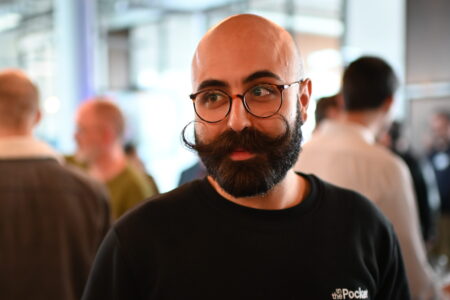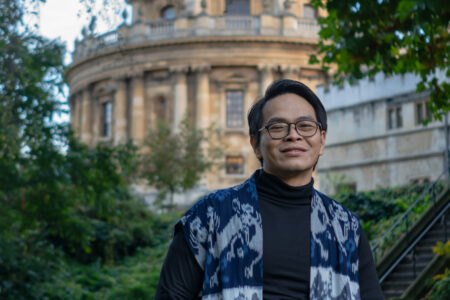
I recently spoke to a headmaster of an international school in Singapore, who said that back in the 90s, everyone thought that computers and laptops would replace teachers.
Evidently, they did not. But, indeed, the ones who knew how to use them correctly were ahead of the crowd when it came to digital innovation for education.
“Digital innovation” sounds like two big words that nobody, especially students, would care about.
The thing is, it has everything to do with how they’re learning in university, the most important era of any young person’s life.
While AI hasn’t replaced humans as teachers yet, a lot of changes are afoot – especially with the increasing use of technology in teaching.
As Acting Head of Innovation and Learning Experience at Taylor’s University in Malaysia, Puteri Sofia Binti Amirnuddin knows this intimately.

Amirnuddin in action at Taylor’s University Malaysia. Source: Puteri Sofia Binti Amirnuddin
Digital innovation: are educators keeping up?
Having taught at Taylor’s for many years, Amirnuddin was happy to share how the university drove innovation through its programmes and offerings. But more importantly, its educators were a prime example.
“Taylor’s provides a lot of support – we’re very mindful of our offerings because technology is changing so fast,” Amirnuddin said. “Now we have generative AI, Grok, Gemini, ChatGPT and so many other platforms, so the university provides training for its lecturers every single month.”
I was impressed. It never really did occur to me that aside from students, their educators would also be the ones receiving training from industry professionals about the latest and greatest in technology development. I asked what they would be expected to learn.
“These training sessions and workshops basically help and guide lecturers on how to follow current trends and help make their lessons more attractive,” Amirnuddin explained. “For example, our latest sessions involve how lecturers can use generative artificial intelligence to enhance their teaching pedagogies, making learning to be more engaging, personalized and efficient.”
I grinned slightly. All I could think about was how students would most likely use ChatGPT in the middle of the night when they were squeezing out last-minute assignments – and this is from personal experience. I only wished I had a mini, digital version of my lecturer to consult then.
My next question was about what key skills Amirnuddin thought were necessary for educators to thrive in today’s increasingly digital landscape.
“Let’s say you just finished your PhD, and you want to embark onto teaching,” she said. “The first thing you need to be able to do is to learn fast. You need to be adaptive and creative, because you’ll no longer be in an environment where you have your teacher or lecturer to help you because, well, you’re the teacher now.”
Being tech-savvy was one thing, but being able to adapt to changes is far more important, she shared. “Even if you learn something new and get good at it, there’ll be something else next year – like jumping from version 2.0 to 3.0. Then that will be something new you have to explore and execute, and it’s not easy keeping up with these changes.”
Being an educator comes with many other challenges. There were just so many other things to juggle on top of keeping up with digital innovation – there’s writing research papers, getting grant applications, providing consultations to students, and continuously working to elevate the overall learning experience.
“My friends who are lawyers say that it’s hard – they should try teaching,” Amirnuddin joked.

She received the “President’s Award for Transformative Teaching and Learning”, the highest award conferred by the President of Taylor’s University. Source: Puteri Sofia Binti Amirnuddin
Her advice for educators
Most schools and universities have online platforms to plan, implement, and manage learning processes, enhancing both the student and educator experience.
Think Blackboard Learn, Moodle, Google Classroom, Schoology and more – there are 73.8 million learning management systems (LMS) users worldwide, and the LMS market is expected to balloon from roughly US$22 billion in 2023 to around US$52 billion in 2032.
“To succeed in an online environment, educators really need to master these learning management systems,” said Amirnuddin. “It’s not just a place to upload your materials or slides – it’s so much more than a depository of information. You have to make it interactive, like embed interactive quizzes into articles, or integrate branching scenarios in videos.”
The aforementioned incorporation of generative artificial intelligence is another example. The execution? Surprisingly simple.
“Lecturers can innovate their teaching by integrating, for example ChatGPT to create dynamic, personalized and engaging learning experiences. The current presentation slides can be enhanced by using ChatGPT tool to provide a more simplified explanations of complex topics. Lecturers can also create a FAQ section for each topic, offering instant and personalised feedback based on the common questions that students ask every semester.”
And while this may seem like common sense to every educator, Amirnuddin strongly advocates for student feedback when it comes to digital innovation. Her advice stems from her own experience – back in 2018, she first heard about using augmented reality (AR) in education while she was still a lecturer.
“Some lecturers were like, yeah, we can’t do that,” she said, laughing. “But I was keen on finding out how to make it effective for teaching. I experimented with it first – big failure, of course – but I collected feedback from my students and continuously improved how I used the technology. This resulted in subsequent batches really appreciating the use of AR for their assessments.”
I was curious to know how it worked. Amirnuddin was happy to share how Taylor’s did it.
“We have a new department called Vortex that was established two years ago, and it specialises in reality technology like AR, VR and XR,” she said. “Lecturers can visit the department and have a conversation with the director, and see how they can best implement these technologies for their particular module.”
She then gave me a scenario. Imagine studying criminology with VR, and using the technology to examine a real crime scene, complete with dead bodies, blood, and even the smell.
“Yes, it can do that,” she affirmed keenly.
The thought of it made me shudder a little, but I understood what she meant. I spoke to an international school in Vietnam last month that implemented VR into their science labs – this meant students could go in and have a 360-degree close-up of a DNA strain, for example, or observe procedures like extracting reptile organs.
Indeed, we will continue to see many schools and universities embrace these new technologies.

She is active in sharing her insights with other educators around the world. Source: Puteri Sofia Binti Amirnuddin
If you could design the perfect online experience, what would it look like?
Amirnuddin’s answer was fairly quick. The Metaverse – a parallel, digitalised world of what we currently live in.
“Think of having an avatar that represents you, that could go to the office, bank, or do grocery shipping while you stay at home,” she said. “So your avatar could essentially go to the bank for you while you’re getting other things done. But this will require a lot of investment, because it’s so limited in terms of the current space available for development.”
She went on to explain how this would fit in an educational context. “Students can learn how to interact with people, especially for those who are timid. They can learn how to engage with others, make friends, and have their lectures in their avatar form.”
I was familiar with this concept. After all, one of my favourite movies is Ready Player One, a science fiction action film set in 2045, where most of the human population uses a virtual reality simulation platform called the OASIS to escape the real world. A good movie for gamers, I might add.
But Amirnuddin pointed out one drawback – the need for regulation. “How do you behave appropriately in the metaverse world?” she asked. “There’s a lot of considerations that you need to take into account, like harassment, for example. How would that translate into a real offence when it’s an avatar touching another avatar?”
Even though she’s now pioneering digital innovation for the online learning programmes at Taylor’s, I could tell that she was still passionate about the law. “As a law lecturer, this scenario is a great way to get students to think outside their comfort zone,” she added. “Such is the role of a lecturer, after all.”










